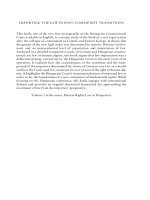Breakthrough Strategies to Solve Performance_8 ppt
Bạn đang xem bản rút gọn của tài liệu. Xem và tải ngay bản đầy đủ của tài liệu tại đây (262.77 KB, 30 trang )
256
Feedback is an interesting management and
communication tool. Managers will acknowledge that they
want it and need it. They will seek out their bosses, check
with their clients or observe their people to determine how
they are doing. The breakfast of champions. Yet, they
aren’t as regular and consistent in giving it. Managing
results means continually giving feedback. It is feedback
that energizes and propels action.
Team Collaboration
Collaboration is an interesting word when considering
management. It is a tool for the coach, but is it a result of
management or an action? Collaboration isn’t communication or
cooperation. It is a higher level skill built around the values noted
in Chapter 1. For the StaffCoach™, it is a result which leads to a
greater result.
To improve performance, motivation and buy-in, trust and
respect are necessary for long-term successes. Collaborating and
communicating synergistically make the results-focus of your
management even more meaningful. The quicker you can bring
your team’s skills to the level where they can collaborate, the
quicker you increase outcomes.
If team decisions are based on the arbitrary opinion of your
management or that of the loudest and most forceful team
member, you can expect only minimum support and even less
enthusiasm from the team in implementing them. The joint
discussion and decision making generated by collaboration
respects each member’s insights and gives you the opportunity to
capitalize on all the combined strengths. This builds in the
necessary flexibility to accommodate special circumstances that
can arise. When your team is collaborating on performance, they
are setting up that performance for optimum results.
Loss of self-esteem is built on failure. It’s no fun missing a
deadline, messing up a project or causing your team to mishandle
a customer. When you have harnessed the energy of the team in
achieving results, their collaborative effort is much stronger than
any one member. When there is failure, there is discussion,
Coaching, Mentoring and Managing
7
TEAMFLY
Team-Fly
®
7
planning and support. Collaboration raises the esteem level of
individuals and their group. With collaboration as your goal, team
members will buy in to the team’s accountabilities.
Summary
Once your team sees that what they do makes a difference to
the organization and is valued by you, they will perform at higher
levels. Managing within the StaffCoach™ Model ensures that.
Performance Coach Gail Cohen notes that success evolves from
understanding the correct order of have-do-be: I have this and do
this and thus am who I am. Your coaching elicits their innate
strengths, your mentoring increases their abilities to do, and your
counseling shapes who they can be. By managing through
developing people, delegating accountability, overcoming hurdles
and dealing with complaints, you become a motivator for
increased results.
Your employees need you more than a pay raise. When you
manage through providing personal thanks, making time for your
team, and giving them consistent and constant feedback, you
energize them for the increased pressures and challenges that are a
reality in today’s workplace.
Creating an open environment through M.E.T. and continually
keeping associates clear on the why, what, and how of their
individual and joint responsibilities add to job satisfaction. You
handle the stressors and frustrations that occur through supplying
information, involving your people and rewarding performance.
By doing these StaffCoaching™ actions, your management
develops a sense of ownership and gives each associate a chance
to grow and learn. Those are actions to celebrate. Celebrating
success is the action you take to perpetuate the coaching cycle.
StaffCoaching™ is managing as a motivator. It recognizes that
your results do come through your people.
257
Managing Within the StaffCoaching™ Model
258
Chapter Quiz
1. Explain the V + E = M formula for making a team
project “do-able.”
V ____________________________________________
E ____________________________________________
M____________________________________________
2. What are the four “P’s” that prepare the StaffCoach™ for
leadership resistance?
_____________________________________________
_____________________________________________
_____________________________________________
3. Name three of the five elements necessary to overcome
project objections and/or complaints.
_____________________________________________
_____________________________________________
_____________________________________________
4. List the five questions that need answers in order to
motivate a team to complete a project.
_____________________________________________
_____________________________________________
_____________________________________________
5. What is the significance of M.E.T.?
M____________________________________________
E ____________________________________________
T ____________________________________________
Coaching, Mentoring and Managing
7
?
HAPTER 8
C
So What and Who Cares!
259
An old management adage is act as if. This suggests that
if you do something and keep doing it, soon you will become
successful at it. In terms of self-confidence, the belief is that
acting as if you were confident will eventually result in you
being confident.
StaffCoaching™ is a never-ending process. Once you
achieve new levels of performance, those levels become the
new standard. You start the process all over again. As your
people grow and succeed, they, in turn, regenerate the
process. Achievement builds trust, trust builds respect. There
is more communication, people honor each other,
disagreement is a means of innovation — and the process
goes on.
There is no one right way, no specific order to perform
your StaffCoaching™ roles. You begin where performance
dictates, coach with your associate or the team, or as a mentor
or counselor. You use the role you need at that moment to
match the problem. This manual has given you a model and a
series of guides to facilitate and strengthen your own
judgment.
8
Teamwork is a
journey, not a
destination.
260
The Coach Attitude
We began this book by identifying those values which
successful coaches embody. Coaches imprint their values on the
people who are on their team. Inherent in each value is a positive
attitude. An important responsibility of yours as the StaffCoach™
is to exhibit a positive attitude. Your attitude translates those
values into team activity that supports company objectives. You
project and transfer these positive values through specific actions.
1. Setting an example
2. Being fair and equitable
3. Seeking the participation and involvement of each
team member
4. Honoring each member of your team
Exercise
Following are three scenarios. Each one reflects one of the
three ways of projecting a positive StaffCoach™ philosophy. Each
scenario is done first the “right way” and then the “wrong way.”
See if you can spot the StaffCoach™ techniques that aren’t
implemented … as well as those that are implemented in
projecting a positive philosophy to team members.
1. Setting an Example
The Right Way
Coach:
Well, let’s take a break and pick back up in about
10 minutes, okay?
(As all leave but Jenny) I think we’re getting some good
ideas for this new project, don’t you?
Jenny:
Yes. No thanks to Nancy.
Coach:
What do you mean?
Coaching, Mentoring and Managing
8
8
Jenny:
Nothing she’s said has been new. They’re the same ideas
we heard and rejected last time we had a brainstorm
session.
Coach:
I like her open sharing. I think some of her thoughts
have potential.
Jenny:
Give me a break.
Coach:
Jenny, because an idea wasn’t quite right for one project
doesn’t mean it couldn’t work for another. New is relative.
Jenny:
If you say so.
Coach:
Relax and enjoy the session. Or better yet, try to think of
something you could add to ideas you don’t like that could
make them better. You’re good at things like that, just like
Nancy is good at telephone sales.
Exercise Analysis
What did the StaffCoach™ do right?
__________________________________________________
__________________________________________________
What would you have done differently? Why?
__________________________________________________
__________________________________________________
261
So What and Who Cares!
262
What should StaffCoach™ follow-up be as a result of
this scenario?
__________________________________________________
__________________________________________________
The Wrong Way
Coach:
Well, let’s take a break and pick back up in about
10 minutes, okay?
(As all leave but Jenny) I think we’re getting some good
ideas for this new project, don’t you?
Jenny:
Yes. No thanks to Nancy.
Coach:
Well, everybody has bad days once in a while.
Jenny:
Bad? Nothing she’s said has been new. They’re the
same ideas we heard and rejected last time we had a
brainstorm session.
Coach:
Yeah. We’ve got to be patient with her. Besides, we’re
making good progress in spite of her. Let’s just let her talk
once in a while and hope we keep getting good ideas from
the rest of us.
Exercise Analysis
What did the StaffCoach™ do wrong?
__________________________________________________
__________________________________________________
Coaching, Mentoring and Managing
8
8
What would you have done differently? Why?
__________________________________________________
__________________________________________________
What should StaffCoach™ follow-up be as a result of
this scenario?
__________________________________________________
__________________________________________________
2. Being Fair and Equitable
The Right Way
Jean:
Claire, Rita just told me someone would probably have to
visit the Dallas client next weekend. Is that true?
Claire:
Yes. I just heard about it an hour ago myself.
Jean:
Well, I know it’s my turn to go, but my sister and her
family are going to be in town that weekend. Can you
please get someone else to do it?
Claire:
I can ask if someone would like to trade with you and …
Jean:
No one will! Everybody hates that client.
Claire:
That sounds like one huge generalization.
Jean:
Why don’t you send the new girl? She hasn’t been
assigned a spot on the travel roster yet. She’d probably
consider it an honor.
263
So What and Who Cares!
264
Claire:
No, I don’t think that would be good. I want her to travel
with someone else a few times until she learns the ropes.
But I’ll tell you what I will do.
Jean:
What?
Claire:
If nobody will trade with you, I think I could probably go
to Dallas that weekend.
Exercise Analysis
What did Claire do right?
__________________________________________________
__________________________________________________
What would you have done differently? Why?
__________________________________________________
__________________________________________________
What should StaffCoach™ follow-up be as a result of
this scenario?
__________________________________________________
__________________________________________________
The Wrong Way
Jean:
Claire, Rita just told me someone would probably have to
visit the Dallas client next weekend. Is that true?
Claire:
Yes. I just heard about it an hour ago myself.
Coaching, Mentoring and Managing
8
8
Jean:
Well, I know it’s my turn to go, but my sister and her
family are going to be in town that weekend. Can you
please get someone else to do it?
Claire:
I can ask if someone would like to trade with you and …
Jean:
No one will! Everybody hates that client. Why don’t you
send the new girl? She hasn’t been assigned a spot on the
travel roster yet.
Claire:
I don’t know. That could be a little like throwing a sheep to
the wolves.
Jean:
Or it could be the best thing that’s ever happened. She’s a
Mexican-American and the client is, too. It might end up
being the perfect match.
Claire:
Umm. Well, okay. But this is just between you and me—
and if we lose a promising new girl because of this, it will
be your job to find a new one.
Exercise Analysis
What did Claire do wrong?
__________________________________________________
__________________________________________________
What would you have done differently? Why?
__________________________________________________
__________________________________________________
265
So What and Who Cares!
266
What should StaffCoach™ follow-up be as a result of
this scenario?
__________________________________________________
__________________________________________________
3. Seeking Participation and Involvement
The Right Way
Barb:
So how much computer equipment is missing?
Joan:
About $6,000 worth. Two units and a hard disk.
Barb:
Any ideas about how it happened?
Joan:
None. Except I know it wasn’t anyone on the team. Ever
since you gave us the key to the equipment room, each of
us has taken turns with hourly inventory.
Barb:
What does security say about it?
Joan:
That it was probably an inside job. But I still say that it
wasn’t one of the team, Barb. No one would betray the
trust the company gave us by giving us access to that room.
Barb:
I believe that, too. I certainly have no reason to
think otherwise.
Joan:
But you probably want the key back, right?
Barb:
No. I want your team to work out a system with security
that makes it impossible for someone to get out of here
with $6,000 worth of equipment. And one more thing.
Coaching, Mentoring and Managing
8
TEAMFLY
Team-Fly
®
8
Joan:
What’s that?
Barb:
Tell the team I really like the increased figures I saw
last week.
Exercise Analysis
What did Barb do right?
__________________________________________________
__________________________________________________
What would you have done differently? Why?
__________________________________________________
__________________________________________________
What should StaffCoach™ follow-up be as a result of
this scenario?
__________________________________________________
__________________________________________________
The Wrong Way
Barb:
So how much computer equipment is missing?
Joan:
About $6,000 worth. Two units and a hard disk.
Barb:
Any ideas about how it happened?
267
So What and Who Cares!
268
Joan:
None. Except I know it wasn’t anyone on the team. Ever
since you gave us the key to the equipment room, each of
us has taken turns with hourly inventory.
Barb:
Well, I’m afraid I’m going to need that key back, anyway
… at least until we can prove it was no one on the team.
Joan:
I wish you wouldn’t, Barb. It will look like you
suspect everyone.
Barb:
Maybe. But I can’t risk another theft while we’re
investigating the first one. Upper management would
think I was crazy!
Exercise Analysis
What did Barb do wrong?
__________________________________________________
__________________________________________________
What would you have done differently? Why?
__________________________________________________
__________________________________________________
What should StaffCoach™ follow-up be as a result of
this scenario?
__________________________________________________
__________________________________________________
Coaching, Mentoring and Managing
8
8
Attitude and Values
The StaffCoaching™ Model focuses your attention on the
constant imprinting of values. If someone is turning in a
performance that is above standard, you communicate specific
values through the role of a mentor. If it’s standard performance,
those values come through in your coaching. If it’s substandard,
you honor and respect the associate through your counseling. To
be effective, you demonstrate the values of flexibility and
sensitivity to the needs of your people.
Betty Eadie wrote in Handbook for the Heart, “The more you
notice the love, the miracles, and the beauty around you, the more
love comes into your life. The more you love, the greater your
ability to love. And the process perpetuates itself.” This is the real
reward for mastering the values of the StaffCoach™. The more
you value your people, supporting them, energizing them, guiding
and encouraging them, the more you honor them. They in turn
respect, appreciate and act on your direction and advice. The
process perpetuates itself.
When employees are asked who made an impact on them and
what caused that impact, specific values and attitudes are
addressed. From these comments, an encouraging, influential
manager can be summarized as one who:
• Listens to you, really listens.
• Respects your abilities, believes in you.
• Sees what you do right as well as pointing out what you
do wrong.
• Can delegate responsibility.
• Has enthusiasm.
• Has a sense of humor.
• Admits mistakes herself.
• Gives you credit for your ideas.
• Recognizes when you need a lift and is there.
• Is interested in you as a person.
• Is at peace with herself.
269
So What and Who Cares!
270
• Has consistent rules and has the staff play a part in
developing those rules.
• Is a good teacher, willing to share ideas.
• Criticizes constructively.
• Follows through on promises.
• Is honest, genuine, real.
The Key Ingredients
The StaffCoaching™ skills that encourage performance
improvement are sustained by continuous assessment of results
and constant adjustments in your approach. As your people
contribute and as successes increase in terms of improvement, you
know your approach is right. This dynamic process requires you to
be adept at change. Knowledge of your options strengthens your
ability to see change as a positive.
Keep your focus on what your people need to improve and to
support their own development. Your associates require seven
specific things from your coaching. Each in turn demands actions
by you to take them to that next level of performance. To review,
your people benefit from these basic ingredients for
obtaining results.
1. A basic understanding of your expectations concerning
their jobs.
You enable this by:
• Developing with them clarity on what their jobs, their
roles, their responsibilities, necessary relationships
and required results are.
• Involving them in goal setting.
• Agreeing to measurements to track their performance.
Coaching, Mentoring and Managing
8
“Nature cannot
avoid chaos when
creating a star.”
— Nietzsche
8
2. A continued awareness of what is expected of
individuals and their integration within the team.
You enable this by:
• Keeping your people aware of organizational goals,
vision, mission, changes and needs.
• Creating understanding about the importance and
contribution of each team member and the team in
regard to the organization and change.
• Working with the team members as changes in
priority necessitate a change in plans, implementation
or organization of work.
3. The opportunity and necessity of involvement in
planning performance strategies and in
decision making.
You enable this by:
• Encouraging and implementing associates’ ideas.
• Rewarding involvement and risk taking.
• Delegating the roles and responsibilities of the
StaffCoach™.
4. Continuous and constant support, direction
and encouragement.
You enable this by:
• Encouraging their questions and points
of disagreement.
• Providing guidance or correction when
problems occur.
• Leading them to resources and to awareness about
additional considerations.
5. Regular feedback on performance before, during and
after tasks.
You enable this by:
• Frequently reviewing results in relation to each action
and the goals, as projects go on.
271
So What and Who Cares!
272
• Openly and honestly letting associates know what
they are doing in relation to their own performance
and the team.
• Discussing performance in terms of their potential.
6. Recognize and reward performance based on
individual improvements.
You enable this by:
• Expressing appreciation for the work and the
team member.
• Calling attention, privately and publicly,
to improvements.
• Celebrating accomplishments.
7. Establish a work environment that respects and
facilitates individual responsibility and self-growth.
You enable this by:
• Establishing relationships with team members that
honor them as capable and talented individuals.
• Underscoring their strengths and achievements.
• Sharing insights, success stories and resources.
Notice how each ingredient emphasizes one approach more
than another within the StaffCoach™ Model. Coaching sets
expectations, mentoring furthers understanding, counseling sets or
resets direction. All three roles involve, give feedback, reward and
encourage self-development. High-performing teams are
interactive and interdependent; these basic ingredients of
StaffCoaching™ minimize the frictions and challenges.
Tools for Your Team
StaffCoaching™ gives your associates innumerable tools.
Consider: Your purpose is to improve performance in order to get
results for your organization. You get those results through
coaching, mentoring and counseling your people to achieve
greater performance. By adapting your approaches of supporting
and encouraging, energizing and instructing, guiding and
Coaching, Mentoring and Managing
8
8
correcting, you give your people real tools for their own
self-management.
• The ability to make choices
Coaching teaches people that the choices they make cause
the outcomes they get. Supporting them encourages their
own analysis of what and how to do things.
• Taking risks and trying new ways
Pushing people to higher performance levels necessitates
that they move out of their comfort zones. Success can
breed stagnation, and habit can initiate fear in trying
different methods.
• Self-analysis
Encouraging performance change and asking for
associates’ opinions on how to do this facilitates reflecting
on their own strengths and thought processes. Insights into
their own behavior give them the energy and courage to
change.
• Self-awareness
There are often huge gaps between what people think they
do and what they actually do. Your feedback, honesty and
sharing of information can help associates understand
what they do and say and the impact they have on other
team members.
• The need for practice
Counseling better ways to do a job requires practice in
order to achieve mastery. By insisting on practice and
improvement, you give your people the discipline to
continue building on skills and not accepting the
status quo.
• Personal commitment
As you reward and celebrate team communication and
collaboration, you facilitate a sense of commitment in
your team members. Nobody will commit to losing. Your
associates realize a sense of commitment by the results
and achievements, the vision and security you provide.
273
So What and Who Cares!
274
• The ability to collaborate
Talking is usually at someone rather than with someone.
Teaching your people how to dialogue — talk with —
gives them an ability to collaborate. Rewarding team
successes strengthens their appreciation of consensus.
They better understand that either they win together, or it
isn’t a win.
What’s in it for them, your people, is intertwined in what’s in
it for you. Achieving results through your people gives them the
same tools that give you successes. Few people who have
achieved real acclaim can say they did it alone. Someone helped
them help themselves. Your actions may be so subtle, so well
orchestrated, that your people are unaware or unappreciative of the
time. Regardless, you have a very positive impact. Your people
develop real job skills and career skills that will benefit them on
the job, at home, in their community endeavors, and with their
personal interests.
The Wisdom of Coaching
Joe Gilliam, a leading author and corporate coach, notes that
StaffCoaching™ isn’t about a best leadership style or about MBO
(Management By Objectives). Both are important. Coaching,
however, is about serving. The qualities of the StaffCoach™ can
be summarized by three words: permission, protection
and process.
Giving your people permission to try harder, grow and stretch,
supports them and builds self-esteem. Your responsibility
concerning protection reminds you that achievements and
recognition belong to the team. You take accountability for the
failures. The process is ever-changing as you coach and mentor
and counsel.
When your team realizes that you do give them permission,
will protect their integrity and are there for them, trust and
collaboration bring about synergy. Your people grow, develop and
succeed in three ways, including:
Coaching, Mentoring and Managing
8
“We can’t do really
big things every
day. If we’re really
serious about
walking the talk all
the time, we have
to focus on the
small stuff.”
— Eric Harvey
8
1. Trial and error, pain and suffering
2. Finding someone successful and copying what they do
3. Benefiting from your coaching, mentoring and counseling
Watching you, listening to you and doing what you direct
grow performance. Your team watches and listens because of the
support and acceptance that permeate everything you do with and
for your team.
Exercise
An exercise to increase your own wisdom as well as your
impact on your people centers around appreciating your people as
your most valuable assets.
1. Think about the number of accomplishments that your
associates achieved in the last month. These can be small
or large, individual or team. Consider a number that
represents the amount of accomplishments or results
they caused.
2. Now, count the amount of times you recognized,
acknowledged or rewarded accomplishments and
achievements of your people.
3. Compare those two numbers.
275
So What and Who Cares!
276
Exercise Analysis
Rarely do the numbers match. The opportunities for
recognizing accomplishments seldom equal the amount of times a
coach tells her people how great, successful and skilled they are.
On average, a good coach acknowledges performance
improvement one out of every four times.
So what? Who cares? You better. The whole StaffCoach™
Model is based on performance-management techniques and
behavior modification. You get what you reward. Focus on
recognition of a behavior and you will get more of that behavior.
Coach positively, communicate positively, reward positively. Your
people care. Your organization benefits.
Nonperformance occurs not because of a flaw on your
people’s part. Certainly they do or don’t do something that gives
you poor results or lesser performance than you require. But
whose fault is that? The premise of this manual makes that clear:
You cause, encourage, set up results. Employee or team non-
performance occurs because of your poor coaching.
StaffCoaching™ is about the interventions you take to build
performance improvement. The old upper-management challenge,
“That’s what you did yesterday; what are you going to do for me
today?” turns into a positive IF you recognize yesterday’s
successes and build on those achievements. Continuous
improvement is possible with coaching wisdom and consistency.
Lasting Impact
Your most important impact as a manager and coach centers
on your people — what they do. A significant role of coaching is
creating the work environment that allows employees to be
motivated. All associates want to be magnificent. You facilitate
their ability to excel by supporting and instructing and guiding.
Encourage your people to find balance in their lives and model
how. Enthusiasm and celebration will allow this. One wise coach
provided her people with these guiding words:
Coaching, Mentoring and Managing
8
TEAMFLY
Team-Fly
®
8
• Take time for work; it is the price of success.
• Take time to think; it is the source of power.
• Take time to play; it is the secret of youth.
• Take time to read; it is the foundation of wisdom.
• Take time to be friendly; it is the road to happiness.
• Take time to dream; it’s hitching your wagon to a star.
• Take time to love; it is the highest joy of life.
• Take time to laugh; it is the music of the soul.
Give your people the resources and support to be magnificent.
Give them permission and protection. A story about Pablo Picasso
illustrates how you can have lasting impact. When a patron asked
him what she could do to support the painter’s success, Picasso
responded, “Get out of my light.”
You are at your best when you give your associates your time,
your insights, your encouragement and enthusiasm, and then step
out of the way.
The rules for success keep changing, but success stays
centered. You succeed in having an impact by realizing that your
ideas and your knowledge aren’t enough. Serve your people’s
fundamental needs for recognition and appreciation. Relentlessly
push your team to improve. Value their performance.
Consider this: If Mozart and Paul McCartney traded places in
history, would Mozart become the greatest rock star of our time?
Would McCartney have been the greatest composer of that era?
Both had prodigious work ethics, spectacular dexterity, compelling
ambition, and the charisma to charm royal audiences as well as
common laborers. How about Jack Welch and Mother Teresa?
Both had a passionate vision, strong beliefs, a crowd of zealous
followers. Would they be as successful if they found themselves in
each other’s shoes?
The answer is “yes” for the same reason that you will succeed
in whatever industry or career you choose. The inherent qualities
that make artists great, leaders outstanding and coaches excel are
relevant and unchanging regardless of time or audience. Those
qualities are respect for your people, flexibility, communication,
277
So What and Who Cares!
278
singular vision, and unwavering focus on results. When your
purpose is outward, on your people, your impact is lasting.
In Chicken Soup for the Soul, the authors went back to
1100 A.D. for words of wisdom. It serves as a fitting conclusion to
your importance as a coach and your reason for being: modeling
performance improvement. We have so many lofty goals and
aspirations. We look outward to what we can do. It’s easy to
overlook the answer: a continuous act of becoming.
“When I was young and free and my imagination had no
limits, I dreamed of changing the world. As I grew older and
wiser, I discovered the world would not change, so I shortened my
sights somewhat and decided to change only my country.
“But it, too, seemed immovable.
“As I grew into my twilight years, in one last desperate
attempt, I settled for changing only my family, those closest to me,
but alas, they would have none of it.
“And now as I lie on my deathbed, I suddenly realize: If I had
only changed myself first, then by example I would have changed
my family.
“From my inspiration and encouragement, I would then have
been able to better my country and, who knows, I may have even
changed the world.”
Coaching, Mentoring and Managing
8
NDEX
I
279
15-5-10 formula 130, 151
3-1-3 formula 96–97
A
ABCs of ensuring understanding 57
Ash, Mary Kay x
Ashe, Arthur 2
attitude and values 269–270
Austin, Nancy 222
authority-driven thinkers 135–136
B
Beecher, Henry Ward 51
behavior modification 189–192, 276
C
Carlyle, Thomas 51
case study 18–21, 34–35, 60–62, 72–75, 118–122,
154–155, 187–189, 207–210
Cather, Willa 143
cautions for coach 111–112
chapter quiz 36, 77, 124, 158–159, 198, 225–226, 258
chapter summary 35, 76, 123, 157–158, 197,
224–225, 257
280
checklist
look before you leap 217
responding to team troubles 213–216
Churchill, Winston 47
clarity 3–6, 19, 26
coaching role 80–111
affirming and acknowledging 81, 104–108
clarifying and verifying 81, 90–103
detached leadership 239
hurdles to performing 238–247
involvement and trust 80, 82–90
motivating and inspiring 81, 108–111
personality 237–238
commitment and mutual support 210–212
common activities for coach 113–114
complaints, five ways to quiet 253–256
confidence building 3, 9-10, 19, 26
confidentiality 3, 17, 20, 26, 49, 183, 210
confrontation, philosophy of 169–172
confrontation process, five-step 172–176
counsel, opportunities to 163–164
counseling
guidelines for 168
keys to effective 165–167
results of effective 195
D
deductive thinkers 136
delegating 232–233
developing trust 83–87
Devine, Dan 79
Disraeli, Benjamin 195
Dryden, John 243
E
effective coaching interactions, steps for 112–113
effective mentoring, outcome of 152–156
awareness of organizational politics and culture
152–153
appreciation of networking 153
proactive approaches to their tasks 153–154
Coaching, Mentoring and Managing









